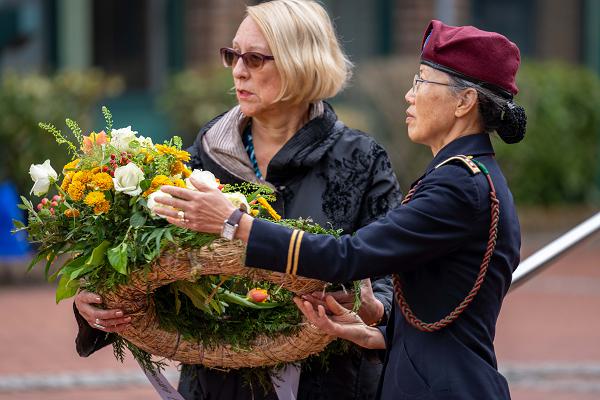
Hamminkeln, Germany. (March 31, 2025): When Americans are asked what was the biggest airborne operation in World War II they are likely to cite Market Garden, the ill-fated invasion of Holland. But it wasn’t the biggest. In the above photo, Army Captain Monika Stoy presents a wreath marking the 80th anniversary of Operation Varsity, the largest single-day airborne drop of the war.
The date was March 24, 1945, and the allies had reached the Rhine river, Germany’s last natural barrier to an allied invasion. Breaching the Rhine would allow the Allies to access to Northern Germany and ultimately Berlin. Led by British General Bernard Montgomery, allied forces mobilized 16,000 troops and thousands of aircraft in the final major airborne assault of the war.
The plans called for dropping two divisions from the U.S. XVIII Airborne Corps, under Major General Matthew B. Ridgway, to capture key bridges and to disrupt German defenses. The airlift involved 541 transport aircraft and a further 1,050 troop-carriers towing 1,350 gliders. The German forces defending the area were shocked at the speed in which the two airborne divisions landed in their midst. In the fierce battle that followed, fifty-six aircraft were lost along with twenty one transport aircraft. An additional fifty nine planes were damaged by antiaircraft fire and sixteen bombers from the Eighth Air Force were shot down during supply drops.
The operation was a success, but costly. The two divisions suffered more than three thousand wounded, missing, or killed while capturing over three thousand prisoners of war. The high casualty rate was attributed to the operation being launched in full daylight rather than a traditional night assault. General Montgomery insisted on a daylight raid due to the chaos of the Normandy invasion where troops were scattered all over their drop zones.
Unlike Market Garden, Operation Varsity was a success with both divisions capturing their assigned bridges and securing towns that could have delayed the advance of the allied ground forces. This operation was the last major airborne assault of the war.


